
Kunzea pomifera, commonly known as muntries, emu apples, native cranberries, munthari, muntaberry or monterry, is a low-growing or prostrate shrub with hairy stems, small, mostly egg-shaped leaves, groups of white flowers on the ends of the branches and fleshy, more or less spherical, edible fruit.

Eremophila divaricata, also known as spreading emu bush, is a flowering plant in the figwort family, Scrophulariaceae and is endemic to Australia. It is a shrub with stiff, spreading, tangled branches which are often spiny on their ends, erect leaves and mauve to lilac-coloured flowers.
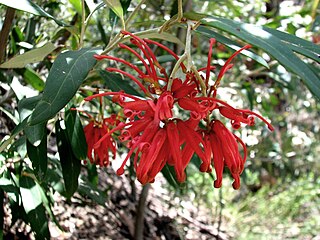
Grevillea victoriae, also known as royal grevillea or mountain grevillea, is a species of flowering plant in the family Proteaceae and is endemic to mountainous regions of south-eastern continental Australia. It is an erect to spreading shrub with elliptic to lance-shaped leaves, and pendulous clusters of red to orange flowers.

Billardiera cymosa, commonly known as sweet apple-berry or love fruit, is a species of flowering plant in the family Pittosporaceae and is endemic to south-eastern continental Australia. It is usually a slender climber that has narrowly egg-shaped leaves and pale blue or pale purplish flowers arranged in groups of about five to twelve.

Lasiopetalum behrii, commonly known as the pink velvet bush, is a species of flowering plant in the family Malvaceae and is endemic to southern continental Australia. It is an erect shrub with lance-shaped, narrowly oblong to narrowly elliptic leaves and groups of white to pink and reddish-brown flowers.

Grevillea parvula , commonly known as Genoa grevillea, is a species of flowering plant in the family Proteaceae and is endemic to an area near the border between New South Wales and Victoria in south-eastern continental Australia. It is a spreading to erect shrub, usually with elliptic leaves, and down-turned clusters of pinkish to red flowers.
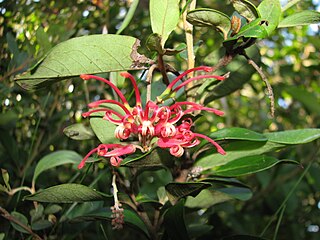
Grevillea miqueliana is a species of flowering plant in the family Proteaceae and is endemic to Victoria in Australia. It is an erect to spreading shrub with elliptic to egg-shaped leaves and clusters of red and orange or yellow flowers.

Grevillea brevifolia, commonly known as Cobberas grevillea, is a species of flowering plant in the family Proteaceae and is endemic to south-eastern continental Australia. It is a spreading shrub with hairy branchlets, elliptic leaves and clusters of hairy red flowers.
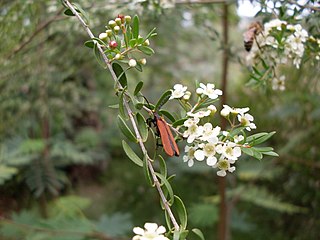
Sannantha pluriflora, commonly known as tall baeckea, is a species of flowering plant in the myrtle family, Myrtaceae, and is endemic to continental southeastern Australia. It is a shrub or small tree with lance-shaped to elliptic leaves, and groups of two to nine white flowers arranged in umbels in leaf axils.

Podolobium procumbens, commonly known as trailing shaggy-pea, trailing podolobium or trailing oxylobium, is a flowering plant in the family Fabaceae and is endemic to south-eastern Australia. It is a trailing small shrub with oval-shaped leaves and orange pea-like flowers.

Philotheca trachyphylla, commonly known as rock wax-flower, is a species of plant in the family Rutaceae and is endemic to south-eastern Australia. It is a shrub or small tree with glandular-warty, oblong to narrow egg-shaped leaves and white flowers arranged singly or in twos or threes, in leaf axils.

Pultenaea densifolia, commonly known as dense-leaved bush-pea, is a species of flowering plant in the family Fabaceae and is endemic to southern continental Australia. It is a spreading or low-lying shrub with broadly egg-shaped, down-curved leaves and clusters of purple or yellow, red and purple flowers.

Hibbertia ericifolia is a species of flowering plant in the family Dilleniaceae and is endemic to south-eastern Australia. It is small, sometimes low-lying to spreading shrub with wiry stems, linear to narrow elliptic leaves, and yellow flowers arranged on the ends of branchlets, with ten to twenty-four stamens arranged around the three carpels.

Kunzea leptospermoides, commonly known as Yarra burgan, is a flowering plant in Myrtaceae, the myrtle family, and is endemic to Victoria, Australia. It is an erect shrub or small tree with narrow leaves and white flowers crowded near the ends of the branches in spring.

Kunzea phylicoides, commonly known as the slender burgan, is a flowering plant in the myrtle family, Myrtaceae and is endemic to south-eastern Australia. It is an erect shrub with drooping branches, fibrous or corky bark, bright green, narrow leaves and clusters of white flowers in spring.
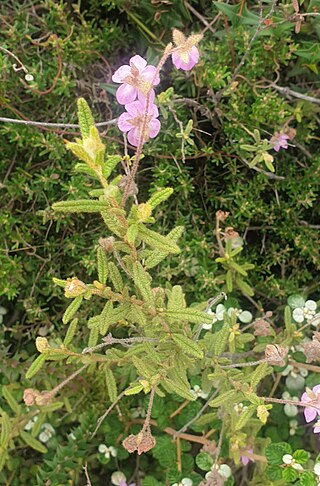
Thomasia petalocalyx, commonly known as paper flower, is a species of flowering plant in the family Malvaceae and is endemic to southern Australia. It is a shrub with wrinkled, oblong to egg-shaped leaves and cup-shaped mauve flowers.

Pultenaea canaliculata, commonly known as coast bush-pea, is a species of flowering plant in the family Fabaceae and is endemic to coastal areas of southern continental Australia. It is an rigid, spreading shrub with hairy, cylindrical leaves, and yellow and crimson flowers.
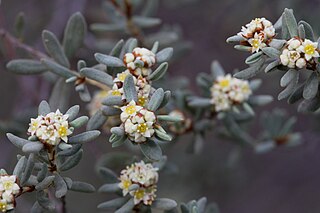
Spyridium subochreatum is a species of flowering plant in the family Rhamnaceae and is endemic to southern continental Australia. It is a low shrub with linear to oblong or narrowly egg-shaped leaves, and dense clusters of creamy-white flowers with dark brown, papery bracts at the base.

Marianthus bignoniaceus, commonly known as orange bell-creeper, is a species of flowering plant in the family Pittosporaceae and is endemic to Victoria. It is a slender climber with egg-shaped or narrowly egg-shaped leaves and green and orange or salmon-pink flowers arranged singly or in pairs.

Brachyloma depressum, commonly known as spreading brachyloma or spreading heath, is a species of flowering plant in the family Ericaceae and is endemic to south-eastern Australia. It is a stiff, prickly shrub with sharply-pointed, lance-shaped leaves and white, tube-shaped flowers.



















